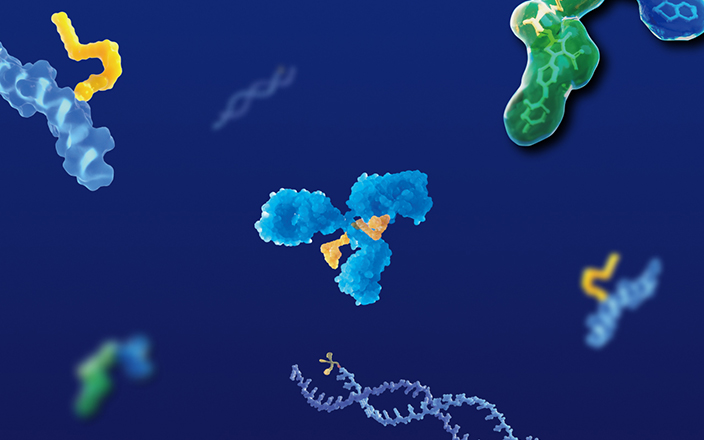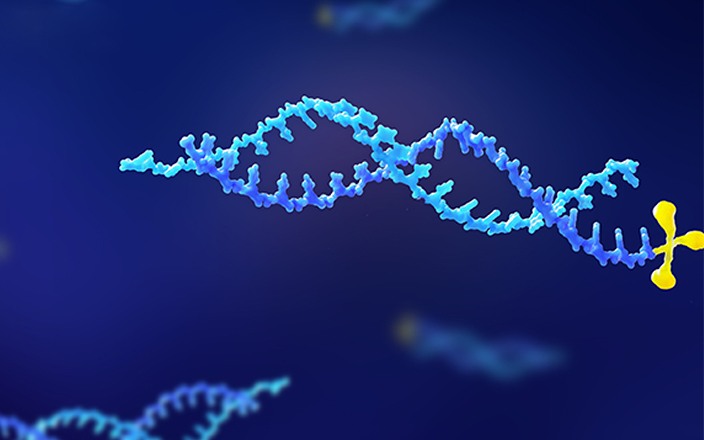As the ongoing development of oligonucleotide drugs, chemical modification and delivery system technologies of oligonucleotides experience significant progress. These advancements have increased the stability and targeting capabilities of oligonucleotide drugs and extended their half-life in the body, thereby improving their efficacy and decreasing the frequency and dosage of administration. Because of the variety of oligonucleotides and the diversity of chemical modifications and drug delivery techniques, it is essential to select an appropriate detection platform for pharmacokinetics (PK) analysis, drug metabolism, and tissue distribution assessment. Among these platforms, Liquid Chromatography–Mass Spectrometry (LC–MS) offers high specificity and wide linear range, but it requires complex sample pretreatment and has low sample throughput. Ligand binding assays (LBA), such as hybridization-based enzyme-linked immunosorbent Assay (HELISA) and Meso Scale Discovery® electrochemiluminescence (MSD® ECL), offer high sensitivity and high throughput capabilities. These assays are widely used for quantitative analysis of oligonucleotides in biological samples, supporting preclinical and clinical PK studies of oligonucleotides. This article introduces the principles, advantages, challenges, and strategies of LBA methods based on the research experience and case study of WuXi AppTec DMPK.
Principle of Ligand Binding Assays (LBA)
LBA is used to detect oligonucleotides, which primarily refer as HELISA and MSD® ECL. HELISA is a method of enzyme-linked immunosorbent assay based on complementary hybridization, which directly or indirectly hybridizes enzyme-labeled nucleic acid probes with the target oligonucleotides adsorbed on a solid carrier. After the addition of a substrate solution, the substrate's hydrogen donor is transformed from a colorless reduced form to a colored oxidized form under the enzyme's action, resulting in a colored substance. By qualitatively or quantitatively detecting the colored product, the concentration of the target oligonucleotide in the sample can be determined. Similar to the HELISA workflow, the MSD®ECL method uses electrochemiluminescent labels to mark the nucleic acid probe and quantitatively measures the target oligonucleotides in the sample by detecting the intensity of the emitted light during electrochemical reactions. Based on the analytical principles, LBA can be categorized into specific steps: one-step, two-step, sandwich, double-bind, and competitive methods (Figure 1).
1. The one-step method involves the use of a single-stranded nucleic acid probe to form a double-stranded body through complementary hybridization with the target oligonucleotide. One end of the nucleic acid probe is labeled with biotin and affixed to a streptavidin plate, whereas the other end is labeled with a detection tag. The one-step method quantifies double-stranded structures labeled with the detection tag using S1 nuclease to remove unhybridized single-stranded probes. The one-step method is unable to differentiate between full-length oligonucleotides and metabolites generated through enzymatic degradation. This susceptibility to cross-hybridization can result in an overestimation of the concentration of the target oligonucleotide.
2. The two-step method involves the use of capture and detection probes. The capture probe comprises one nucleotide sequence complementary to the target oligonucleotide, and an additional nucleotide sequence complementary to the detection probe. One end of the capture probe is labeled with biotin and affixed to a streptavidin plate. The target oligonucleotide complementarily hybridizes with the capture probe and binds to the detection probe under the action of T4 DNA ligase. Simultaneously, the detection probe complementarily hybridizes with the capture probe, followed by the addition of a substrate and detection of the reaction signal. The two-step method is not affected by nucleic acid metabolites degraded at the 3'-end; however, it cannot distinguish between full-length oligonucleotides and nucleic acid metabolites degraded at the 5'-end.
3. The sandwich method also requires capture and detection probes. The capture probe is labeled with biotin at one end and immobilized on a streptavidin plate, whereas the detection probe is labeled with a detection label. The capture and detection probes complementarily hybridize with sequences on the target oligonucleotide, forming a double-stranded structure for quantitative detection. Similar to the one-step method, the sandwich method is also affected by metabolites, leading to an overestimation of the concentration of the target oligonucleotide.
4. The double-bind method, employing capture, detection, and template probes, exhibits good specificity and remains unaffected by metabolites of nucleic acid degradation. The capture probe is labeled with biotin at one end and immobilized on a streptavidin-coated plate, whereas the detection probe is labeled with a detection tag at one end. The template probe can simultaneously hybridize with the capture probe, detection probe, and target oligonucleotide, forming an intact double-stranded structure in the presence of T4 DNA ligase. Subsequently, a substrate solution is added to detect the reaction signal.
5. The competitive method involves the use of a capture probe with the same sequence as that of the target oligonucleotide and a detection probe that is complementary to the target oligonucleotide. The capture probe is labeled with biotin at one end and immobilized on a streptavidin plate, while the detection probe is labeled with a detection tag at the other end. The target oligonucleotide competes with the capture probe to complementarily hybridize with the detection probe. By quantifying the interference of the target oligonucleotide on the expected signal, the concentration of the oligonucleotide in the sample can be detected. However, this method cannot distinguish between the full-length oligonucleotide and metabolites of nucleolytic degradation.

Figure 1. Principle of ELISA: (A) one-step (B) two-step, (C) sandwich, (D) double-bind, and (E) competitive methods 1
When selecting an analytical method, besides sensitivity, the selectivity and specificity of the method should be considered. If there is potential interference from metabolic products, the two-step or double-bind method can be chosen.
Advantages of Ligand Binding Assays (LBA)
1. High Sensitivity of LBA
Resembling LC–FL methods based on hybridization principles, HELISA easily offers low detection limits of 0.5 ng/mL and even lower limits of detection at 0.05 ng/mL with MSD®ECL. This makes it suitable for preclinical, late-phase, and clinical PK studies of oligonucleotides, and for the detection of biological samples in low-dose groups or long experimental periods. MSD®ECL utilizes SULFO-TAGTM as the chemiluminescent substrate. Because SULFO-TAGTM with relatively small molecular weight has minimal steric hindrance, which makes it easy to label antibodies without interfering with their capacity to bind to the analyte. SULFO-TAGTM generates highly efficient, stable, and continuous electrochemiluminescent signals, thereby substantially improving detection sensitivity. MSD®ECL can simultaneously detect oligonucleotides at both high and low abundance levels, with a dynamic range spanning 4–5 orders of magnitude.
2. High Throughput of LBA
Compared to chromatographic methods, the HELISA method hardly requires sample pretreatment and chromatography-related linear injection methods, thus significantly reducing the detection time. Moreover, the utilization of automated equipment such as the TECAN (Männedorf, Switzerland) and Hamilton (Nevada, USA) liquid handling workstations, automated plate washers, and the HP D300 digital dispenser could reduce the handling time and manual pipetting errors, as well as increase sample throughput and the success rate of sample analysis.
3. Independence from Chemical Modifications and Delivery Systems
The HELISA method demonstrates better tolerance to chemical modifications of oligonucleotides than that of the qPCR methods, with its detection sensitivity remaining unaffected. This method can be used to detect biological samples of N-acetylgalactosamine (GalNAc)-conjugated oligonucleotides, LNP-delivered oligonucleotides, and other delivery system-based oligonucleotides in preclinical and clinical research. Additionally, the MSD®ECL method reduces sample consumption and enables multiplex detection, providing more data for studying rare samples.
Challenges of Ligand Binding Assays (LBA)
1. Probe Design
The capture and detection design of probes should essentially ensure proper affinity for the oligonucleotide analyte and minimize potential self-annealing. During the method development stage, screening of capture and detection probes is necessary. Locked nucleic acid (LNA) is a novel nucleic acid analog that contains a 2'-O, 4'-C methylene bridge (Figure 2). This bridging moiety is locked in the 3'-endo conformation, restricting the flexibility of the furanose ring and locking the structure into a rigid bicyclic form. LNA exhibits a high affinity towards complementary DNA or RNA, which enhances the thermal stability of the hybridized double-stranded structure and the specificity of probe-target sequence hybridization 2. The MSD®ECL method using LNA capture and detection probes has been used to measure short interfering RNA (siRNA) in serum and tissue homogenates of preclinical biological samples 3.

Figure 2. Structural comparison of DNA, RNA, and LNA nucleotides 4
Additionally, optimizing the design of probes also contributes to improving the selectivity of the HELISA method. For example, if 3' or 5'-end metabolites are expected, optimizing the length of capture and detection probe sequences can reduce hybridization between the metabolites and probes, thereby enhancing the sensitivity of the method.
2. Metabolite
Compared to LC-MS methods, HELISA lacks specificity for the target oligonucleotide in biological samples, making it hard to distinguish between the full-length oligonucleotide and long-chain metabolites such as n-1 and n-2. This could lead to cross-hybridization and overestimation of the concentration of the target oligonucleotide. Therefore, it is necessary to prioritize the use of LC-MS methods for metabolic stability studies and develop probes and methods specifically targeting the oligonucleotide analyte and major metabolites for preclinical and clinical research purposes. In addition, it can be used to synthesize potential metabolites and evaluate their quantitative impact on the test oligonucleotide during method development and validation. Additionally, selecting an appropriate HELISA method can reduce interference from metabolites on oligonucleotide analytes. As previously mentioned, the two-step and double-bind methods, which introduce T4 DNA ligase in the ASSAY, can further enhance the specificity of the HELISA method.
Case Study: Quantitative Analysis of GalNAc-siRNA Conjugated Oligonucleotides Using LBA Methods
WuXi AppTec DMPK has developed two bioanalytical methods, based on HELISA and MSD®ECL, for quantitatively analyzing GalNAc-siRNA conjugated oligonucleotides in monkey serum samples. These methods have been methodologically validated to assess their specificity, selectivity, sensitivity, linear range, and accuracy. The method uses a sandwich method, with a biotin-labeled LNA capture probe and a detection-labeled LNA detection probe to hybridize with the antisense strand (AS) of the GalNAc-siRNA duplex. The concentration of the AS is measured, and the concentration of GalNAc-siRNA is reported based on the AS concentration. The sensitivity of the HELISA and MSD®ECL methods is 0.5 and 0.05 ng/mL, respectively.
1. Standard Curve and Quantification Range
Figure 3 illustrates the quantitative performance of the HELISA method in analyzing spiked monkey serum samples after sample processing, with the lower limit of quantification (LLOQ) as low as 0.5 ng/mL and the linear range from 0.50 to 50.0 ng/mL.

Figure 3. Standard curve of GalNAc-siRNA in monkey serum using the HELISA method
(0.5-50.0 ng/mL, Curve Fit: 4-Parameter Logistic, Weighting Factor: 1/values2, R2=1.000)
Figure 4 illustrates the quantitative performance of the MSD®ECL method in the analysis of spiked monkey serum samples after sample processing. The LLOQ is as low as 0.05 ng/mL, and the linear ranges from 0.050 to 10.0 ng/mL.

Figure 4. Standard curve of GalNAc- siRNA in monkey serum using the MSD® method
(Linear range: 0.05–10.0 ng/mL, curve fit: 4-parameter logistic, weighting factor: 1/Y2, R2 = 0.9995)
2. Accuracy and Precision
In the HELISA method, the within- and between-batch accuracy of the quality control samples ranges from 84.2% to 112.8% and 98.5% to 101.5%, respectively. The within- and between-batch precision percentage relative standard deviation (%RSD) ranges from 1.7% to 15.1% and 6.7% to 13.7%, respectively. In the MSD®ECL method, the within-batch accuracy of the quality control samples ranges from 92.3% to 103.9%, and the between-batch accuracy ranges from 95.4% to 101.6%. The within-batch precision %RSD, ranges from 0.9% to 7.0%, while the between-batch precision %RSD ranges from 2.5% to 6.0%. These data meet the regulatory requirements for CV% (±20%) and Bias% (±20%).
3. Interference Detection of Metabolites
During the method development process, the potential interference of two metabolites (AS 3'n-1 and AS 3'n-2) and the sense strand (SS) of GalNAc-siRNA double-stranded structures on the MSD®ECL sandwich method was evaluated. Monkey serum samples were prepared with high and low concentrations of GalNAc-siRNA, AS 3'n-1, AS 3'n-2, and SS and detected using the MSD®ECL sandwich method. Compared to GalNAc-siRNA, the two potential metabolites (AS 3'n-1 and AS 3'n-2) showed significant signal response during the detection, which suggests lower specificity for GalNAc-siRNA in monkey serum samples. To address this issue, it is recommended to prioritize metabolic stability studies using LC-MS methods before sample analysis. Assay results have demonstrated that quantification of the AS in GalNAc-siRNA double-stranded structures using the MSD sandwich method is not affected by the presence of the SS.
Figure 5 shows the signal response of the two potential metabolites (AS 3'n-1 and AS 3'n-2) and the SS chain detected in monkey serum using the MSD®ECL method.

Figure 5. Detection of GalNAc-siRNA, AS 3'n-1, AS 3'n-2, and SS in monkey serum using MSD® ECL method
Conclusion
HELISA offers high sensitivity and throughput, which is widely used for the quantitative analysis of oligonucleotides in preclinical and clinical PK samples. The Non-GLP bioanalysis team of WuXi AppTec DMPK has comprehensive capabilities in the bioanalysis of oligonucleotides. We have developed and established the five bioanalytical platforms, including LC-triple quadrupole tandem MS (LC-MS/MS), LC–high-resolution mass spectrometry (LC–HRMS), hybridization-based LC-FL detection, LBA, and qPCR. These platforms support oligonucleotide bioanalysis from early drug screening to investigational new drug (IND) application. With diverse bioanalytical platforms and extensive experience in oligonucleotide method development, we are capable of generating and delivering high-quality in vitro and in vivo data, thereby accelerating the drug development process.

Figure 6. WuXi AppTec oligonucleotide drug metabolism and pharmacokinetic (DMPK) bioanalysis platform
Click here to learn more about the strategies for oligonucleotides, or talk to a WuXi AppTec expert today to get the support you need to achieve your drug development goals.
Authors: Hong Sun, Yafei Gao, Zhiyu Li, Nan Zhao
Committed to accelerating drug discovery and development, we offer a full range of discovery screening, preclinical development, clinical drug metabolism, and pharmacokinetic (DMPK) platforms and services. With research facilities in the United States (New Jersey) and China (Shanghai, Suzhou, Nanjing, and Nantong), 1,000+ scientists, and over fifteen years of experience in Investigational New Drug (IND) application, our DMPK team at WuXi AppTec are serving 1,500+ global clients, and have successfully supported 1,200+ IND applications.
Reference
1 Kotapati S, Deshpande M, Jashnani A, Thakkar D, Xu H, Dollinger G. The role of ligand-binding assay and LC-MS in the bioanalysis of complex protein and oligonucleotide therapeutics. Bioanalysis. 2021 Jun;13(11):931-954.
2 Karkare S, Bhatnagar D. Promising nucleic acid analogs and mimics: characteristic features and applications of PNA, LNA, and morpholino. Appl. Microbiol. Biotechnol. 2006;71:575–86
3 Thayer MB, Lade JM, Doherty D, Xie F, Basiri B, Barnaby OS, Bala NS, Rock BM. Application of Locked Nucleic Acid Oligonucleotides for siRNA Preclinical Bioanalytics. Sci Rep. 2019 Mar 5;9(1):3566.
4 http://www.microsynth.com/files/Inhalte/PDFs/Oligosynthesis/Flyer_Oligo_LNA.pdf
Related Services and Platforms




-

 DMPK BioanalysisLearn More
DMPK BioanalysisLearn More -

 Novel Drug Modalities DMPK Enabling PlatformsLearn More
Novel Drug Modalities DMPK Enabling PlatformsLearn More -

 Novel Drug Modalities BioanalysisLearn More
Novel Drug Modalities BioanalysisLearn More -

 Small Molecules BioanalysisLearn More
Small Molecules BioanalysisLearn More -

 Bioanalytical Instrument PlatformLearn More
Bioanalytical Instrument PlatformLearn More -

 PROTAC DMPK ServicesLearn More
PROTAC DMPK ServicesLearn More -

 ADC DMPK ServicesLearn More
ADC DMPK ServicesLearn More -

 Oligo DMPK ServicesLearn More
Oligo DMPK ServicesLearn More -

 PDC DMPK ServicesLearn More
PDC DMPK ServicesLearn More -

 Peptide DMPK ServicesLearn More
Peptide DMPK ServicesLearn More -

 mRNA DMPK ServicesLearn More
mRNA DMPK ServicesLearn More -

 Covalent Drugs DMPK ServicesLearn More
Covalent Drugs DMPK ServicesLearn More
Stay Connected
Keep up with the latest news and insights.
















